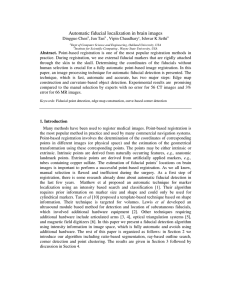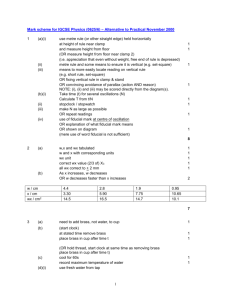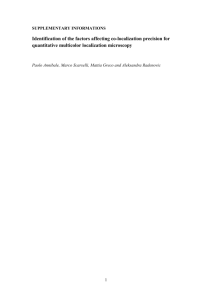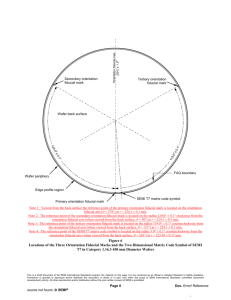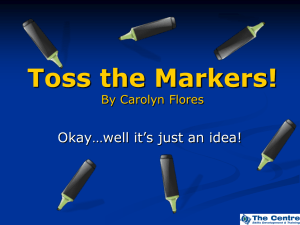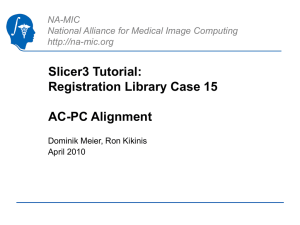A Template Based Technique for Automatic Detection of Fiducial Markers
advertisement
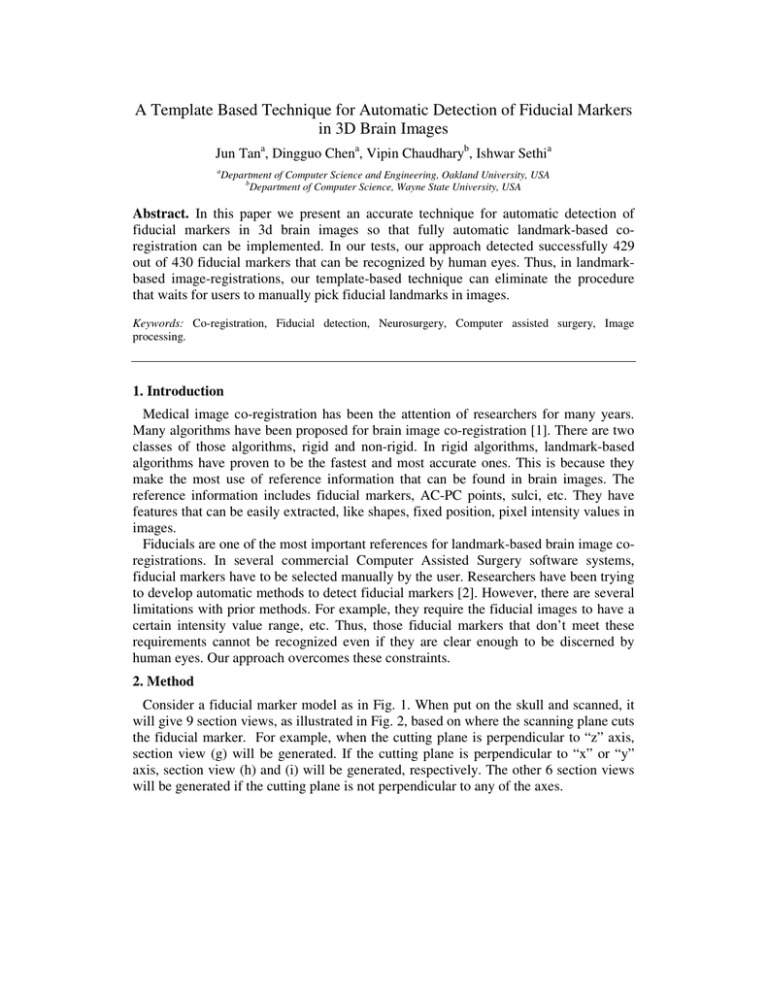
A Template Based Technique for Automatic Detection of Fiducial Markers in 3D Brain Images Jun Tana, Dingguo Chena, Vipin Chaudharyb, Ishwar Sethia a Department of Computer Science and Engineering, Oakland University, USA b Department of Computer Science, Wayne State University, USA Abstract. In this paper we present an accurate technique for automatic detection of fiducial markers in 3d brain images so that fully automatic landmark-based coregistration can be implemented. In our tests, our approach detected successfully 429 out of 430 fiducial markers that can be recognized by human eyes. Thus, in landmarkbased image-registrations, our template-based technique can eliminate the procedure that waits for users to manually pick fiducial landmarks in images. Keywords: Co-registration, Fiducial detection, Neurosurgery, Computer assisted surgery, Image processing. 1. Introduction Medical image co-registration has been the attention of researchers for many years. Many algorithms have been proposed for brain image co-registration [1]. There are two classes of those algorithms, rigid and non-rigid. In rigid algorithms, landmark-based algorithms have proven to be the fastest and most accurate ones. This is because they make the most use of reference information that can be found in brain images. The reference information includes fiducial markers, AC-PC points, sulci, etc. They have features that can be easily extracted, like shapes, fixed position, pixel intensity values in images. Fiducials are one of the most important references for landmark-based brain image coregistrations. In several commercial Computer Assisted Surgery software systems, fiducial markers have to be selected manually by the user. Researchers have been trying to develop automatic methods to detect fiducial markers [2]. However, there are several limitations with prior methods. For example, they require the fiducial images to have a certain intensity value range, etc. Thus, those fiducial markers that don’t meet these requirements cannot be recognized even if they are clear enough to be discerned by human eyes. Our approach overcomes these constraints. 2. Method Consider a fiducial marker model as in Fig. 1. When put on the skull and scanned, it will give 9 section views, as illustrated in Fig. 2, based on where the scanning plane cuts the fiducial marker. For example, when the cutting plane is perpendicular to “z” axis, section view (g) will be generated. If the cutting plane is perpendicular to “x” or “y” axis, section view (h) and (i) will be generated, respectively. The other 6 section views will be generated if the cutting plane is not perpendicular to any of the axes. z y x Fig. 1. A fiducial marker model. (a) (b) (c) (d) (e) (f) (g) (h) (i) Fig. 2. Section views of a fiducial with cutting plane in different directions. We have divided the 9 section views into 4 categories. (e) (f) (g) belong to category 0. (h) belongs to category 1. (i) belongs to category 2. The remaining belong to category 3. Our approach makes use only of categories 0, 1, and 2. Given a 3D image as in Fig. 3, when we perform edge detection [3] on a sequence of successive images that completely contains a fiducial marker, there are two possibilities, stated as separate templates below. Fig. 3. Multi-planar view of a fiducial marker on the top of a brain Template 1: There is at least one category 0 section view as (a) and (b) in Fig. 3, where the first row are the scanned images of fiducial markers, and the second row are the edges detected on them. The detected edges are two concentric circles. These circles are not completely circumvented by other edges of the image. This makes sure that the image can only possibly (depends on detection result) be fiducial marker set on skull of brain, and impossibly be some similar images generated on other structures inside the brain. (a) (b) (c) Fig. 4: Axial views of a fiducial marker and the edges detected in three continuous slices. Template 2: There is a sequence of one or more category 1 sections followed one or more category 2 sections, then followed by one or more category 1 section. Furthermore, both before and after this sequence, there is no fiducial marker. For category 1, the edge contains one peak. We call this “Edge type 1”. For category 2, the edge contains two peaks. We call this “Edge type 2”. Otherwise, the edge contains no peak. We call this “Edge type 0”. Thus, considering the number of peaks in the edges of fiducial marker image sequences, we will have string “0111112221000” for Fig. 5 and string“01122222211100” for Fig. 6. Then we shrink the strings by removing continuous duplicated digits keeping only one of them. We have a string “01210” for both Fig. 5 and 6. 0 1 1 1 1 1 2 2 2 1 0 0 0 Fig. 5. Sagittal views of the fiducial markers in Fig. 3 and the edges detected in 13 continuous slices, and the number of peaks in the edges. 0 1 1 2 2 2 2 2 2 1 1 1 0 0 Fig. 6. Coronal views of the fiducial markers in Fig. 3 and the edges detected in 14 continuous slices, and the number of peaks in the edges. For both cases 1 and 2, the concentric circles and peaks are detected within an area of only a fiducial. We have chosen the maximum possible fiducial size as 12mm. Given a 3D image “IMG” that has been reconstructed from a DICOM image sequence which contains N slices, let I(a,i) stand for image of axial slice i, I(s,j) stand for image of sagittal slice j, and I(c,k) stand for image of coronal slice k. Our approach is summarized by the following algorithm: 1. Define Ma, Ms, and Mc as matrices with the same dimension size as “IMG” and all element values set to 0. 2. Let i=1. 3. Perform edge detection on I(a,i). 4. If there is a “Template 1”. Let Ma(x, y) =1, where (x, y) is the coordinate of the centre of the concentric circles. 5. Traverse along the brain boundary. For each “Edge type 2” met, perform edge detection on I(a,i-1) , I(a,i-2) ,…, and I(a,i+1) , I(a,i+2) , …, and find the string of peak numbers for the same brain boundary locations in this image sequence. If a “Template 2” is found, let Ma(x,y) = 2, where (x,y) is the coordinate of the valley between the two peaks. 6. If neither “Template 1” nor “Template 2” is found, nor i=N, let i = i+1. Goto 1. 7. For each element in Ms with value 1, say Ms(x, y, z)=1, do: a) let j = x, replace I(a,i) with I(s,j), and Ma with Ms, repeat step 3-5. b) let k = y, replace I(a,i) with I(c,j), and Ma with Mc, repeat step 3-5. 8. If for both 7(a) and 7(b), a “Template 2” is found, there is a fiducial marker at coordinate (x, y, z). 9. For each element in Ms with value 2, say Ms(x, y, z),=2 do: a) let j = x, replace I(a,i) with I(s,j), and Ma with Ms, repeat step 3-5. b) let k = y, replace I(a,i) with I(c,j), and Ma with Mc, repeat step 3-5. 10. If for both 9(a) and 9(b), either a “Template 1” or a “Template 2” is found, there is a fiducial marker at coordinate (x, y, z). An interesting data point we found is that it is non-trivial to detect edges to find the peaks for “Template 2”. We have tried many algorithms as “Sobel”, “Laplacian”, “Prewiit”, “Zero-cross”, “Canny”, etc. The best result is obtained by using “Laplacian” algorithm. Our results are all based on this edge detection algorithm. We also noticed that though “Laplacion” is still not perfect for detecting edges, by considering a sequence of successive images instead of only one image, we have been able to successfully find “Template 2” and eventually find the fiducial markers. 3. Experiments and Results We have tested our approach on 18 cases. Only regular MR (slice size in pixel: 256*256 or 512*512) and CT (slice size in pixel: 512*512) images were used in our tests. All the image data are presented as DICOM image sequences. Each file is the image file of one slice (scanned axially). There are 45 MR modalities and 11 CT modalities altogether. There are also 7 iMRI modalities (slice size in pixel: 128*128). However, due to the poor image quality, our technique doesn’t work for those images in iMRI modalities. We have obtained very promising results. For example, Table 1 presents detailed information about two tests we have done on the first two cases. We show the modalities contained in each case, slice number of image sequences, number of fiducial markers that have been set on head and scanned, etc. Table 1 Information of case images and the results of fiducial detection. (* The number of Fiducials that can be seen on images is the same as the number of fiducials that can be recognized and selected manually. Because a fiducial can be selected by users only when it is visually recognizable and vice versa.) Case 1 Case 2 Modality CT MR T1 MR T1 CT MR T1 MR T2 MR T2 Image size 512*512 256*256 256*256 512*512 256*256 256*256 256*256 Number of slices 78 75 100 55 75 100 100 (size in z coordinate) Number of Fiducial 12 12 12 12 12 12 12 markers set on brain Number of discernable Fiducial 9 12 12 8 12 12 12 markers * Number of Fiducials that can be detected 9 12 12 8 12 12 12 automatically by our approach Due to the different quality of images obtained by CT or MR scanners, not all fiducial markers are visible in all modalities. For example, in the CT modality of Case 1, while all 12 can be seen in MR T1 and T2 modalities, only 9 fiducial markers can be recognized visually. We don’t reconstruct those 3 fiducial markers missing in CT modality for two reasons: (1) The missing markers are considered not present in the CT modality since there is no available information of them, like pixel intensity, etc. (2) Because the purpose of detecting fiducial markers is to implement automatic co-registration and not the reverse, we should not make use of fiducial markers’ location information from other modalities to help reconstruct them in CT modality. The last row of Table 1 demonstrates our experiment result. In both cases, our approach detected all fiducial markers that can be seen. No fiducials marker missed the detection, and no detection gives wrong marker location. In all 55 modalities (MR and CT), there are 430 fiducials (107 of which are in CT images). Only one fiducial in an MR modality failed to be detected. The axial view image of that fiducial is shown in Fig. 7. The fiducial marker is not attached to the skull part of the image. The edge detection on this image sequence didn’t generate any recognizable template. Fig. 7. One fiducial marker that failed to be detected by our approach. 4. Conclusion Our technique for automatically detecting fiducial markers demonstrated a high accuracy. It has performed as well as the human eye regardless of pixel intensity value, fiducial marker location, and fiducial marker orientation. Our future work on fiducial detection will be (a) to combine it with co-registration, (b) to test it on high-quality iMRI images, (c) to solve the problem that caused the failure of one fiducial detection mentioned in section 3. References [1] J. B. Antoine Maintz1 and Max A. Viergever, A Survey of Medical Image Registration, Medical Image Analysis, vol2, 1998. [2] Matthew Y. Wang, Calvin R. Maurer, Jr., J. Michael Fitzpatrick, and Robert J. Maciunas., 621 An Automatic Technique for Finding and Localizing Externally Attached Markers in CT and MR Volume Images of the Head, IEEE TRANSACTIONS ON BIOMEDICAL ENGINEERING, VOL. 43, NO. 6, JUNE 1996. [3] Rafael C. Gonzalez, Richard E. Woods, Digital Image Processing (Hardcover), Prentice Hall; 2nd edition (January 15, 2002).
